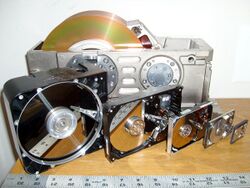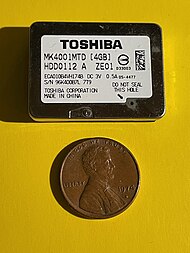Engineering:List of disk drive form factors
Since the invention of the floppy disk drive, various standardized form factors have been used in computing systems. Standardized form factors and interface allow a variety of peripherals and upgrades thereto with no impact to the physical size of a computer system. Drives may slot into a drive bay of the corresponding size.
Compared to flash drives in same form factor, maximum rotating disk drive capacity is much smaller,[citation needed] with 100 TB (As of 2018),[1] and 32 TB for 2.5-inch.[2]
List
| Form factor (inch) |
Status | Dimensions (Dimension in inches unless otherwise noted) |
Largest capacity | Platters (max.) | Capacity per platter (GB) | ||
|---|---|---|---|---|---|---|---|
| Length | Width | Height | |||||
| 3.5 | Current | 5.75 | 4.0 | 0.72[3] or 1.0[4] or 19.99 mm[5] | 30 TB[6] | 10[7] (June 2022)[8] | 2.6TB |
| 2.5 | Current | 4.0 | 2.75 | 5,[9] 7, 9.5,[lower-alpha 1] 12.5, 15 or 19[10] (all mm) |
5 TB[11] (October 2016, no improvement since.) | 5[12] | 1,000 |
| 1.8 | Obsolete | 78.5 mm,[lower-alpha 2] 71 mm[lower-alpha 3] | 54 mm | 5 mm or 8 mm | 320 GB[13] (2009) | 2 | 220[14] |
| 8 | Obsolete | 14.5 | 9.5 | 4.625 | 2.0 GB (1989)[15][16] | Unknown. Minimum, 12 |
Unknown. Minimum, 0.16 |
| 5.25 (FH) | Obsolete | 8.0 | 5.75 | 3.25 | 47 GB[17] (1998) | 14 | 3.36 |
| 5.25 (HH) | Obsolete | 8.0 | 5.75 | 1.625 | 19.3 GB[18] (1998) | 4[lower-alpha 4] | 4.83 |
| 1.3 | Obsolete | 50.8 mm[19] | 36.5 mm[19] | 10.5 mm[19] | 40 GB[20] (2007) | 1 | 40 |
| 1 (CFII/ZIF/IDE-Flex, "Microdrive") | Obsolete | 42.8 mm | 36.4 mm | 5 mm | 20 GB (2006) | 1 | 20 |
| 0.85 | Obsolete | 32 mm | 24 mm | 5 mm | 8 GB[21][22] (2004) | 1 | 8 |
IBM's first hard drive, the IBM 350, used a stack of fifty 24-inch platters and was of a size comparable to two large refrigerators. In 1962, IBM introduced its model 1311 disk, which used six 14-inch (nominal size) platters in a removable pack and was roughly the size of a washing machine. This became a standard platter size and drive form-factor for many years, used also by other manufacturers. The IBM 2314 used platters of the same size in an eleven-high pack and introduced the "drive in a drawer" layout, although the "drawer" was not the complete drive.
Later drives were designed to fit entirely into a chassis that would mount in a 19-inch rack. Digital's RK05 and RL01 were early examples using single 14-inch platters in removable packs, the entire drive fitting in a 10.5-inch-high rack space (six rack units). In the mid-to-late 1980s the similarly sized Fujitsu Eagle, which used (coincidentally) 10.5-inch platters, was a popular product.
Such large platters were never used with microprocessor-based systems. With increasing sales of microcomputers having built in floppy-disk drives (FDDs), HDDs that would fit to the FDD mountings became desirable. Thus HDD Form factors, initially followed those of 8-inch, 5.25-inch, and 3.5-inch floppy disk drives. Because there were no smaller floppy disk drives, smaller HDD form factors developed from product offerings or industry standards.
- 8-inch
- 9.5 in × 4.624 in × 14.25 in (241.3 mm × 117.5 mm × 362 mm). In 1979, Shugart Associates' SA1000 was the first form factor compatible HDD, having the same dimensions and a compatible interface to the 8" FDD.
- 5.25-inch
- 5.75 in × 3.25 in × 8 in (146.1 mm × 82.55 mm × 203 mm). This smaller form factor, first used in an HDD by Seagate in 1980, was the same size as full-height 5 1⁄4-inch-diameter (130 mm) FDD, 3.25-inches high. This is twice as high as "half height"; i.e., 1.63 in (41.4 mm). Most desktop models of drives for optical 120 mm disks (DVD, CD) use the half height 5¼" dimension, but it fell out of fashion for HDDs. The format was standardized as EIA-741 and co-published as SFF-8501 for disk drives, with other SFF-85xx series standards covering related 5.25 inch devices (optical drives, etc.)[23] The Quantum Bigfoot HDD was the last to use it in the late 1990s, with "low-profile" (≈25 mm) and "ultra-low-profile" (≈20 mm) high versions.
- 3.5-inch
- 4 in × 1 in × 5.75 in (101.6 mm × 25.4 mm × 146 mm) = 376.77344 cm³. This smaller form factor is similar to that used in an HDD by Rodime in 1983, which was the same size as the "half height" 3½" FDD, i.e., 1.63 inches high. Today, the 1-inch high ("slimline" or "low-profile") version of this form factor is the most popular form used in most desktops. The format was standardized in terms of dimensions and positions of mounting holes as EIA/ECA-740, co-published as SFF-8301.[24] At least Seagate made 19.99-mm-high drives too.[5] At least Samsung made a low-profile single-disc drive with a height of only 18.288 mm (0.72 in).[3]
- 2.5-inch
- 2.75 in × 0.197–0.75 in × 3.945 in (69.85 mm × 5–19 mm × 100 mm) = 34.925–132.715 cm3. This smaller form factor was introduced by PrairieTek in 1988; there is no corresponding FDD. The 2.5-inch drive format is standardized in the EIA/ECA-720 co-published as SFF-8201; when used with specific connectors, more detailed specifications are SFF-8212 for the 50-pin (ATA laptop) connector, SFF-8223 with the SATA, or SAS connector and SFF-8222 with the SCA-2 connector.[25]
- It came to be widely used for HDDs in mobile devices (laptops, music players, etc.) and for solid-state drives (SSDs), by 2008 replacing some 3.5 inch enterprise-class drives. It is also used in the PlayStation 3 and Xbox 360[26] video game consoles.
- Drives 9.5 mm high became an unofficial standard for all except the largest-capacity laptop drives (usually having two platters inside); 12.5 mm-high drives, typically with three platters, are used for maximum capacity, but will not fit most laptop computers. Enterprise-class drives can have a height up to 15 mm. Seagate released a 7 mm drive aimed at entry level laptops and high end netbooks in December 2009. Western Digital released on April 23, 2013 a hard drive 5 mm in height specifically aimed at Ultrabooks.[27]
- 1.8-inch
- 54 mm × 8 mm × 78.5 mm[lower-alpha 2] = 33.912 cm³. This form factor, originally introduced by Intégral Peripherals in 1991, evolved into the ATA-7 ZIF with dimensions as stated but with a total length of 71mm. Later the micro SATA interface made the total length 78.5mm. The 1.8 inch form factor was used in digital audio players and subnotebooks with a ZIF connector. Later the 1.8 inch form factor drives were updated with a micro SATA connector and the largest drive made was 320GB (Toshiba MK3233GSG). The 1.8 inch form factor was eventually phased out as SSD drives became cheaper to produce and could be built directly onto PCBs to save space.[28] There was an attempt to standardize this format as SFF-8123, but it was cancelled in 2005.[29] SATA revision 2.6 standardized the internal Micro SATA connector and device dimensions.
- 1.3-inch
- 51 mm × 43.8 mm × 10.5 mm. This form factor was used by HP C3013A, C3013B and C3014A, named HP Kittyhawk microdrive, introduced in June 1992.
- 1-inch
- 42.8 mm × 5 mm × 36.4 mm. This form factor was introduced in 1999, as IBM's Microdrive to fit inside a CF Type II slot. Samsung calls the same form factor "1.3 inch" drive in its product literature.
- 0.85-inch
- 24 mm × 5 mm × 32 mm. Toshiba announced this form factor in January 2004 for use in mobile phones and similar applications, including SD/MMC slot compatible HDDs optimized for video storage on 4G handsets. Toshiba manufactured a 4 GB (MK4001MTD) and an 8 GB (MK8003MTD) version and holds the Guinness World Record for the smallest HDD.
(As of 2023), 2.5-inch and 3.5-inch hard disks are the most popular sizes.
By 2009, all manufacturers had discontinued the development of new products for the 1.3-inch, 1-inch and 0.85-inch form factors due to falling prices of flash memory, which has no moving parts.[citation needed]
While these sizes are customarily described by an approximately correct figure in inches, actual sizes have long been specified in millimeters. The older 3.5-inch form factor uses UNC threads, while 2.5-inch drives use metric M3 threads.
Notes
- ↑ Most common
- ↑ 2.0 2.1 This dimension includes a 0.5 mm protrusion of the Micro SATA connector from the device body.
- ↑ Measured on Toshiba MK1011GAH
- ↑ The Quantum Bigfoot TS used a maximum of three platters, other earlier and lower capacity product used up to four platters in a 5.25-inch HH form factor, e.g., Microscience HH1090 circa 1989.
References
- ↑ "Dude, Here's Your 100TB Flash Drive!" (in en-GB). 2018-03-20. https://www.architecting.it/blog/dude-heres-your-100tb-flash-drive/.
- ↑ Chen, Sam. "Samsung Unveils 32TB SSD Leveraging 4th Gen 64-Layer 3D V-NAND" (in en-US). https://www.custompcreview.com/news/samsung-unveils-32tb-ssd-leveraging-4th-gen-64-layer-3d-v-nand/.
- ↑ 3.0 3.1 "Samsung Spinpoint PL40 Product Specification Rev 1.4 (09-09-'03)". 2003. https://www.seagate.com/files/www-content/support-content/documentation/samsung/PL40_r1_4.pdf.
- ↑ "Seagate Exos X16 16TB HDD Review". 2019. https://www.kitguru.net/components/hard-drives/simon-crisp/seagate-exos-x16-16tb-hdd-review/.
- ↑ 5.0 5.1 "Seagate Barracuda 7200.10 Data Sheet". 2007. https://www.seagate.com/docs/pdf/datasheet/disc/ds_barracuda_7200_10.pdf.
- ↑ "Seagate Ships First 30TB+ HAMR Hard Drives". https://www.tomshardware.com/news/seagate-ships-first-30-tb-hamr-hdd-drives.
- ↑ "Ultrastar DC HC670". https://www.westerndigital.com/products/internal-drives/data-center-drives/ultrastar-dc-hc670-hdd#ultrastar-dc-hc670-26-tb.
- ↑ "Western Digital Launched 22TB and 26TB Hard Drives". https://blog.memory4less.com/2022/06/07/western-digital-launched-22tb-and-26tb-hard-drives/.
- ↑ "Western Digital builds 5mm-thick hybrid hard drive, Ultrabook makers sign on early". Engadget. September 10, 2012. https://www.engadget.com/2012/09/10/western-digital-builds-5mm-thick-hybrid-hard-drive/.
- ↑ "Quantum Go*Drive specifications". http://www.4drives.com/DRIVESPECS/QUANTUM/3364.txt.
- ↑ "Seagate Launches Two New BarraCuda Drives That Pack The Speed, Punch (And Game!) Today's Mobile Warriors Demand". October 10, 2016. http://www.seagate.com/about-seagate/news/seagate-launches-two-new-barracuda-drives-pr/?paramChannelName=newsroom.
- ↑ "Seagate Introduces BarraCuda 2.5" HDDs with Up to 5 TB Capacity". October 21, 2016. http://www.anandtech.com/show/10757/seagate-introduces-barracuda-25-mobile-hard-drives-with-up-to-5-tb-capacity.
- ↑ "Toshiba Storage Solutions – MK3233GSG". http://www.toshiba.co.jp/about/press/2009_11/pr0501.htm.
- ↑ "Toshiba MK2239GSL, 220 GB single-platter HDD". http://storage.toshiba.com/techdocs/MKxx39GSL_Data_Sheet.pdf.
- ↑ "Archived copy". http://bitsavers.trailing-edge.com/pdf/fujitsu/disk/FujitsuDriveList.txt.
- ↑ "M2301 Magnetic Disk Unit". IPSJ Computer Museum. http://museum.ipsj.or.jp/en/computer/device/magnetic_disk/0012.html.
- ↑ Seagate Elite 47, shipped 12/97 per 1998 Disk/Trend Report – Rigid Disk Drives
- ↑ Quantum Bigfoot TS, shipped 10/98 per 1999 Disk/Trend Report – Rigid Disk Drives
- ↑ 19.0 19.1 19.2 HP Kittyhawk Personal Storage Modules Data Sheet, 1993
- ↑ "SDK Starts Shipments of 1.3-Inch PMR-Technology-Based HD Media". January 10, 2008. http://www.sdk.co.jp/aa/english/news/2008/aanw_08_0812.html.
- ↑ "Proving that 8 GB, 0.85 inch hard disk drive exists". February 17, 2007. http://digitaljournal.com/article/117340.
- ↑ "Toshiba Enters Guinness World Records Book with the World's Smallest Hard Disk Drive". Toshiba Corp.. March 16, 2004. http://www.toshiba.co.jp/about/press/2004_03/pr1601.htm.
- ↑ "SFF-8500 Specification for Suite of 5.25" Form Factor Specifications". SFF Committee. June 5, 1995. http://ftp.seagate.com/sff/SFF-8500.PDF.
- ↑ "SFF-8301 3.5" Form Factor Drive Dimensions" (PDF). SNIA SFF TA TWG. January 19, 2018. https://members.snia.org/document/dl/25862.
- ↑ "SFF-8201 Specification for Form Factor of 2.5" Disk Drives". SFF Committee. October 28, 2013. http://ftp.seagate.com/sff/SFF-8201.PDF.
- ↑ "Xbox 360 HDD Replacement". July 31, 2010. https://www.ifixit.com/Guide/Xbox+360+HDD+Replacement/3430.
- ↑ Ian Paul (April 23, 2013). "Western Digital rolls out ultra-slim 5 mm Ultrabook drives.". PCWorld. http://www.pcworld.com/article/2036197/western-digital-rolls-out-ultra-slim-5mm-ultrabook-drives.html.
- ↑ "World HDD Market: Key Research Findings 2010". Yano Research Institute. December 15, 2010. http://www.yanoresearch.com/press/pdf/718.pdf.
- ↑ "Specification for 1.8" (60x70mm) w/Serial Attachment Connector, Rev C" (PDF). SFF Committee. January 2005. http://ftp.seagate.com/sff/SFF-8123.TXT.
 |





